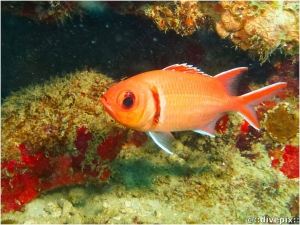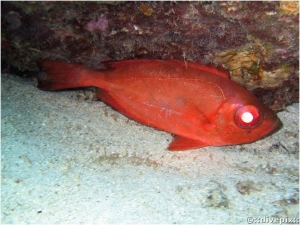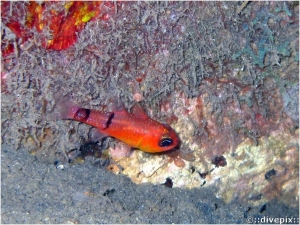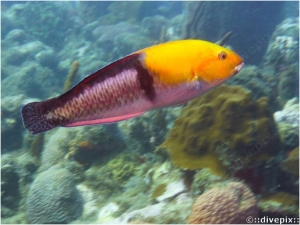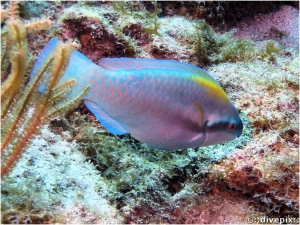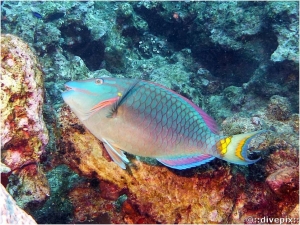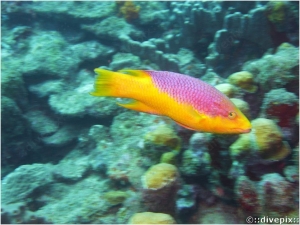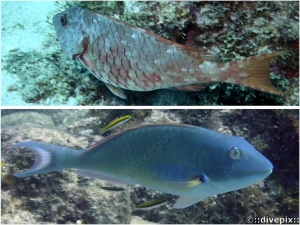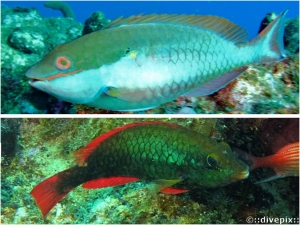




Eric H. Biass
Dusky Cardinalfish
| Aspect: | Silvery or silvery pink, with an overlay matrix of tiny darker dots, hence its latin designation (pigmentaria) |
| Population: | Occasional. |
| Notable feature: | Carries only one darker bar on tail base, which distinguishes it from similarly sized and shaped Barred Cardinalfish (q.v.). |
| Environment: | Around rocks and coral boulders |
| Behaviour: | Easy to approach when spotted at night. |
Blackbar Soldierfish
| Aspect: | Generally bright red body, but may have a lighter shade or even white belly, but always sports a vertical black bar behind the gills. |
| Population: | Common. |
| Notable feature: | All fins have white leading edges. Has this peculiar habit of flipping belly up when close to the roof of a cave or a rock overhang. This is particularly noticeable in the famous cave of the "Jardin de Corail" site, near Ilets Pigeon. |
| Environment: | Recesses and under rock overhangs. |
| Behaviour: | Not scared when in their recesses. |
Bigeye
| Aspect: | Plain red body and fins. |
| Population: | Common. |
| Notable feature: | White doted line raising from gill area, gently arcing backwards to the tail root. |
| Environment: | Under rock and coral bouler overhangs, close to seabed, often deeper waters (20 metres hence) |
| Behaviour: | Easy to approach when found. |
Belted Cardinalfish
| Aspect: | Generally red or orange with colour darkening rearwards. |
| Population: | Occasional, at night or in caves. |
| Notable feature: | Vertical black bar aft mid body, plus thinner double black bars on tail base. |
| Environment: | Around rocks and coral boulders, at depths of beyond 10 metres and generally seen at night. |
| Behaviour: | Ignores divers. |
Yellowhead Wrasse
| Aspect: | Dramatic livery changes according to age or phase. Juveniles are yellow with "fluo blue" side-line, then gently acquire darker upper body to eventually adopt a more sphisticated change of colours, turning a more plain blue or pink body before acquing a greenish forebody to finally stabilise (male phase) with a clear yellow forebody with a full vertical midbody black bar, black rear upper body and white aft belly. |
| Population: | Common. |
| Notable feature: | Whatever the phase (except juvenile) can be easily identified thanks to distinctive scribbly darker lines radiating backwards and upwards from upper rear eye quarters. |
| Environment: | Around rocks and coral boulders. |
| Behaviour: | In constant movement, but will approach a hand digging into the coral sand bottom in the hope of catching food. |
Striped Parrotfish
| Aspect: | All parrotfishes sport a strong elongated oval body boasting large scales, prominent mouth with bill-like frontal teeth (hence the name) with which they bite away at coral. |
| Population: | Less common than other parrotfishes and easily confused with Princess Parrotfish. |
| Notable feature: |
Terminal phase: distguished from other parrotfishes by its pink scale borders; it also features a yellow forehead. Juvenile/Initial phase: white body with three dark longitudinal stripes, the median line running from snout to tail, across eyes. Distinguished from juvenile Princess Parrotfish from lack of black lines on outer edges of tail fin. |
| Environment: | Swims around rocks and coral boulders from which, like all parrotfishes, it violently bites off algae. |
| Behaviour: | In constant movement. |
Stoplight Parrotfish
| Aspect: | All parrotfishes sport a strong elongated oval body boasting large scales, prominent mouth with bill-like frontal teeth (hence the name) with which they bite away at coral. The Stoplight Parrotfish owes its name to the bright yellow spot boasted by terminal phase males on the root of their tail. |
| Population: | Ubiquitous. |
| Notable feature: |
Juvenile: hardly two inches long, light grey body with white dots, green head and orange eyes. Intermediate (can be male or female): Brown to white head, yellow "eyelids" black-rimmed grey-ish and white-ish scales upper body, bright red belly and fins, tail fin end included. Terminal (adult and male only): Overall bright turquoise with lilac to red-rimmed scales, turquoise bordered lilac dorsal and anal fins characteristic bright yellow or orange patch on tail root, similarly coloured crescent on inner portion of tail fin, large lilac blotch on "forehead", lilac line from mouth crack backwards, bright yellow spot on upper gill lid follwed by lilac-pink vertical lines on gill edge. As some of the pictures below show, the Stoplight Parrotfish tends to adopt subdued colours at night while sleeping, Older specimens tend to boast paler colours, |
| Environment: | Swims around rocks and coral boulders from which it violently bites off coral and algae. |
| Behaviour: | Can be approached within one metre. One of the most notable traits of parrotfishes is their habit of strongly biting at coral. They do so so violently that it can clearly be heard by the observing diver. Once an initial hole is made, the edges are easier to bite off, which is why the animal tends to work on a same spot before moving on. The resultant white scars are often mistaken for signs of coral bleaching. |
Spanish Hogfish
| Aspect: | Streamlined body, in total contrast with Hogfish but with similar strong tail fin root, considerably sweptback dorsal and anal fins. As seen here, colours vary considerably, although scarce literature on the specie usually refers to blue-mauve over yellow body livery. Photos herewith taken in Ilets Pigeon area tend to prove otherwise. |
| Population: | Quite common. |
| Notable feature: | Changes gender from female to male according to colony requirement, with males then believed to sport brightest colours. |
| Environment: | Swims in open waters, near feef or close to bottom to feed. |
| Behaviour: | Can be approached, but seldom stops moving. |
Redtail Parrotfish
| Aspect: | Redtail Parrotfish tends to have a slightly more pointed nose. All parrotfishes sport a stong elongated oval body boasting large scales, prominent mouth with bill-like frontal teeth (hence the name) with which they bite away at coral. Difficult to believe that initial and terminal phases seen here belong to the same species. |
| Population: | Terminal phase relatively rare around Ilets Pigeon. |
| Notable feature: |
Initial phase (top in title picture): Mottled white and red-brown. Terminal phase: blue-green, with reddish crescent in tail fin. Ventral area is yellowish, but area immediately behind the pectoral fins is more resolutely blue. |
| Environment: | Swims around rocks and coral boulders from which it violently bites off coral and algae. |
| Behaviour: | Can be approached within one or two metres. |
Redband Parrotfish
| Aspect: |
All parrotfishes sport a strong elongated oval body boasting large scales, prominent mouth with bill-like frontal teeth (hence the name) with which they bite away at coral. The redband parrotfish is somewhat smaller. While most parrotfishes have three essential growth phases (Juvenile, Intermediate and Terminal), the Redband Parrotfish inserts additional physical characteristics between Juvenile and Intermediate phases (unfortunately not yet featured here), but not only: in both its initial and terminal phases, the species has the wherewithal of rapidly and dramatically changing its appearance, especially while resting at night, to make itself look particularly uninviting with the first dorsal fin spines unequivocally deployed as exemplified by photos below. TITLE PHOTO: The combined photo above shows Terminal Phase above Intermediate Phase specimen. Terminal (supermale adult): Light green upper and aft body, lighter underbody and sides just aft the pectoral fins, light red/pink dorsal and anal fins. Red eyes amd orange line runs from mouth crack passing under the eyes. Belly can turn red under certain circumstances at night. Intermediate phase: Overal dark green with bright red dorsal, ventral, anal and tail fins. Can dramatically change appearance, especially at night while resting. Always very marked scales. |
| Population: | Common. |
| Notable feature: |
Terminal: yellow blotch and black stains behind the gills, above the body centerline. Intermediate: white spot just aft the dorsal fin. |
| Environment: | Swims around rocks and coral boulders from which it violently bites off algae (as seen on one of the photos below). |
| Behaviour: | Can easily be approached within one or two metres. |




